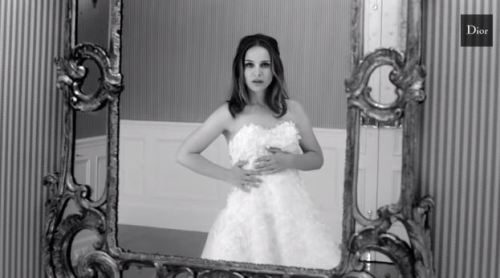Miss Dior’s idea of freedom is limited to ditching one man for anotherFor its latest Miss Dior
Miss Dior’s idea of freedom is limited to ditching one man for anotherFor its latest Miss Dior ad, released to coincide with the prime gifting fragrance moment that is Valentine’s day, French luxury house Christian Dior decided to revisit one of the classic tropes of the romantic storytelling genre: the runaway bride. Long-time face of the brand Natalie Portman returns as Miss Dior, this time directed by Depeche Mode and U2 photographer and music video director Anton Corbjin. On Dior.com, he describes the short as ”The story of a singularly beautiful and inspiring woman taking the boldest of steps toward a future wholly hers.” Wholly hers, but still centred on a man. Walking down the aisle at an idyllic location overlooking a glittering blue Mediterranean sea, Portman has a change of heart. She drops her lily-of-the-valley bouquet, her white heels and her intricate white gown in quick succession, culminating with her stripping to a short little black dress in a field. Nothing says freedom like bare feet and an LBD. Next thing you know, she is on a scorching red calanque, waiting for a helicopter. She climbs up using a rope ladder, puts on a headset. The pilot starts kissing her neck. Cut to a shot of the Eiffel Tower - because no French fragrance ad would be complete without the Eiffel Tower, even though Paris is miles away from the Med. My disappointment with the ad, titled “It’s Miss, Actually”, has nothing to do with geography. I am more than happy to credit the idea of flying a helicopter from the South of France to Paris in the name of creative license. My disappointment is due to the early scene that sets the runaway bride storyline. At the beginning of the ad, Portman corrects a bellman who called her “Madam” with a sweet “It’s Miss, actually”. It had me hope she would ditch her fiancé not for another man, but rather for herself. Coverage of the ad has focused on how it shows that “not all happy endings need an ‘I do.’” (Suzannah Ramsdale at Marieclaire.co.uk) or that “not every fairy-tale has to end in marriage” (Lisa Niven at Vogue.co.uk). Thanks for the reminder. In a first-class example of mansplaining, Matthew Marchak, CEO of strategic communication agency The Eighth Floor, told Luxury Daily: “Honestly, from having a good group of female friends of my own as well as a number of clients whom focus on the female demographic, I think weddings are always on the mind of a woman around Valentine’s Day.” Dior used the wedding theme in its social media campaign in the run up to the ad release, though not as much as it could have. The day before, it posted Save the Date videos on YouTube, containing teasers as well as launching the hashtag #itsmissactually. The runaway bride theme works in feature-length films because you have time to get to know the characters and to root for them. The wedding scene is often the culmination of a story which tends to go like this: Young, Beautiful Woman from a wealthy background is due to marry a man for social reasons; Young, Beautiful Woman meets and falls in love with man less suitable for her milieu but so much more suitable for her heart; Young, Beautiful Woman tries to go through with the wedding but at the last minute, often following a grand gesture from Suitor #2, realises she has to follow her heart and flees. Cue to her and #2 running towards each other. End credits. As seen in: Heartbreaker, Spider-Man 2, It Happened One Night…Due to the way those stories are told, we want Young, Beautiful Woman to go with Suitor #2. Chances are, we know this is what the scenario will give us anyway. Whereas I couldn’t care less whether Miss Dior ends up with the man standing at the altar or with the man in the helicopter because I don’t know either. We are lead to think the helicopter pilot is the one for her because the runaway bride history is so codified in cinema there is no alternative. Nobody is ‘free’ in this ad - from the main character to the director and the viewers, we all depend on the way cinema has formatted our expectations. Indeed, Miss Dior isn’t the only one whose independence is limited by conventions, cinematographic or otherwise, even though the film is meant to laud her disregard for them. Corbjin, though not particularly familiar with the genre through his body of work, seems stuck in the fragrance ad-making codes. With under two minutes to tell his story, he relies on a number of cinematographic and wardrobe clichés. The wedding Miss Dior doesn’t want is told in black and white, switching to saturated colours the minute she decides to run away. The dress is princess wedding at its best, because all women want to be princesses on their wedding day, apparently: couture, white, full skirted, embroidered with intricate flowers. Her fleeing away dress is a lot more sexualised: short, body-con and black. The first scenes represent the kind of wealthy, dreamy lifestyle fragrance houses want to make you believe you buy into by purchasing their product. The Eiffel Tower shot, by its angle and colour as well as the helicopter, reminded me of the classic Paris Je T’Aime Yves Saint Laurent ad. Here are endings Corbjin and Dior could have followed to make the ad more interesting: Miss Dior leaves on her own; Miss Dior initiates the kiss with the pilot; Miss Dior leaves with a woman. But that would probably not have sat very well in a number of markets where homosexuality is frowned upon. Fragrance ads have never been about revolutionising advertising or cinematographic tropes. They are about bringing in enough cash so fashion houses can prosper, something I have no doubt “It’s Miss, actually” will succeed in doing. All photos: Anton Corbijn for Christian Dior Parfums -- source link
Tumblr Blog : fashionabecedaire.tumblr.com
#brand communication#marketing









